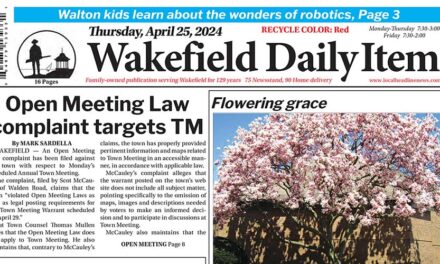By GAIL LOWE
WAKEFIELD — Starting in September, students in Wakefield’s school district will pay 25 cents more for breakfast. At last Tuesday’s school board meeting, members voted unanimously to increase the price from $1.25 to $1.50 per breakfast but the increase will not affect rates that are already reduced, such as those in the free or reduced-lunch program.
Following the vote, Kristen Morello, who heads up the school nutrition program for Wakefield and Reading, gave a report on the Department of Elementary and Secondary Education’s findings for the past three years.
The program in Wakefield was evaluated over a three-day period. The last time such a review took place was nine years ago. Many current staff members had not participated in an evaluation of this kind, said Morello. The findings, she said, were positive.
Wakefield Memorial High School and Greenwood School were selected for site visitations and performed above average in their assessments. The high school was also monitored for the dietary assessment and passed with only minor recommended menu adjustments.
Morello pointed out that this is an extraordinary accomplishment, as the Healthy Hunger-Free Kids Act of 2010 demanded many changes in school nutrition programs, many of which had an implementation date of 2013 or 2014.
The DESE review objectives involved determining whether the School Food Association (Wakefield) met program requirements and whether technical assistance was needed. The objectives also focused on securing any needed corrective action and assessing fiscal action, including recovering improperly paid funds.
Morello said that while food service employees found it “nerve wracking” to have people behind them evaluating their work, the assessments went smoothly. The evaluation included quality of work (knowledge of the job, accuracy, neatness, thoroughness in work, money handling and equipment operation), productivity (amount of work done in a given time), work habits (initiative, compliance with instruction, taking direction, working well without supervision, attendance and punctuality, sanitation and safety), attitude, relationships with others and personal qualities (stability under time pressure, appearance, judgment, flexibility and adaptability and loyalty).
School board member Gregory Liakos asked Morello if a healthier diet was being promoted in schools and if students were actually eating the food offered.
Morello replied that this is a challenge because the school nutrition program mandates that certain goods must be offered to each student, such as a full cup of juice.
“We asked Congress to review this so that kids will eat fruits and vegetables and drink juice without a fight,” she said.
Morello has seen better success at the elementary school level when it comes to kids trying new food items but that waste is a “big national concern.”
“The School Nutrition Association is working on this,” she said. “And I’m working on keeping waste to a minimum.” Morello added that $7,000 was given to the district this year for fruits and vegetables and she expects that more money will be given next year.
Morello responded to a question from Superintendent of Schools Dr. Stephen K. Zrike about where Wakefield stood with the state concerning a “universal breakfast,” and she responded that there is a “big push” on a breakfast mandate but that it has yet to come through.
“It’s on my radar,” she said.
Mandates handed down from the federal government (U.S. Department of Agriculture) in April 2014 require that the following foods be offered:
Grains: For all grade groups, schools must offer at least 1 ounce equivalent of grains each day. The minimum weekly offering varies by age and grade group: 7 oz. for grades K-5, 8 ounces for grades 6-8 and 9 ounces for grades 9-12. Half of grains offered must be whole grain-rich. There is no separate requirement to offer meat/meat alternates in the new school breakfast meal pattern. Schools may offer a meat/meat alternate in place of part of the grains component after the minimum daily grains requirement is offered in the menu or planned breakfast. Alternately, a school may offer a meat/meat alternate as an additional food and not credit it toward any component.
Juice/Fruit/Vegetable: Schools must offer at least one-half cup of fruits and/or vegetables to all age-grade groups. Vegetables and fruits may be offered interchangeably. There are no substitution requirements and no vegetable subgroup requirements. There are no limitations on juice.
Milk: Schools must offer only fat-free (unflavored or flavored) or low-fat (unflavored) milk. For all age-grade groups, schools must offer at least one cup of milk daily. A variety of milk (at least two options) must be offered.
The federal government also keeps an eye on sodium content of an average breakfast. For grades K-5, 540 mg or less; grades 6-8, 600 mg or less; grades 9-12, 640 mg. or less
In closing, Business Administrator Michael Pfifferling offered comments about Morello’s job performance.
“She’s doing a great job,” he said. “She has really made a difference. Morale in the Food Services Department is so much better than it was a few years ago.”




